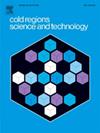Investigating emerging boulder impacts on snowpack ablation
IF 3.8
2区 工程技术
Q1 ENGINEERING, CIVIL
引用次数: 0
Abstract
The impact of emergent boulders within a thinning and melting snowpack remains poorly understood. Our research examines how boulders, exposed by melting snowpack influence the spatial and temporal patterns of snow ablation in the Shár Shaw Tagà Valley, Yukon, Canada. A multimethod approach, combining thermal infrared time-lapse imaging, drone-based photogrammetry, and terrestrial laser scanning, was used to monitor snow surface temperature, elevation changes, and melt variability. This approach underscores the importance of comprehensive techniques in assessing the spatial and temporal variability of snow surface temperature and topography. Results indicate that boulders accelerate snowmelt in their vicinity during the ablation season, with snow surface thermal characteristics shaped by local terrain and meteorological conditions. The fastest rates of ablation occur during periods of mild weather with no precipitation. These findings highlight the role of boulders as micro-scale heat sources that can modify energy fluxes and influence broader melt patterns in subarctic alpine environments. Understanding these processes is essential for improving snowmelt modelling and predicting hydrological changes in mountain regions affected by climate change.

研究新出现的巨石对积雪消融的影响
在变薄和融化的积雪中出现的巨石的影响仍然知之甚少。我们的研究考察了融化积雪暴露的巨石如何影响加拿大育空地区Shár肖塔格谷积雪消融的时空模式。采用热红外延时成像、无人机摄影测量和地面激光扫描相结合的多方法监测积雪表面温度、高程变化和融化变异性。这种方法强调了综合技术在评估雪表面温度和地形的时空变化方面的重要性。结果表明:在消融季节,巨砾加速了其附近地区的融雪,其雪面热特征受当地地形和气象条件的影响。在没有降水的温和天气期间,消融速度最快。这些发现强调了巨石作为微尺度热源的作用,它可以改变能量通量,并影响亚北极高山环境中更广泛的融化模式。了解这些过程对于改善融雪模拟和预测受气候变化影响的山区水文变化至关重要。
本文章由计算机程序翻译,如有差异,请以英文原文为准。
求助全文
约1分钟内获得全文
求助全文
来源期刊

Cold Regions Science and Technology
工程技术-地球科学综合
CiteScore
7.40
自引率
12.20%
发文量
209
审稿时长
4.9 months
期刊介绍:
Cold Regions Science and Technology is an international journal dealing with the science and technical problems of cold environments in both the polar regions and more temperate locations. It includes fundamental aspects of cryospheric sciences which have applications for cold regions problems as well as engineering topics which relate to the cryosphere.
Emphasis is given to applied science with broad coverage of the physical and mechanical aspects of ice (including glaciers and sea ice), snow and snow avalanches, ice-water systems, ice-bonded soils and permafrost.
Relevant aspects of Earth science, materials science, offshore and river ice engineering are also of primary interest. These include icing of ships and structures as well as trafficability in cold environments. Technological advances for cold regions in research, development, and engineering practice are relevant to the journal. Theoretical papers must include a detailed discussion of the potential application of the theory to address cold regions problems. The journal serves a wide range of specialists, providing a medium for interdisciplinary communication and a convenient source of reference.
 求助内容:
求助内容: 应助结果提醒方式:
应助结果提醒方式:


